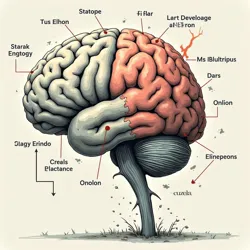Terminal Event
 An artistic rendering of the Terminal Event's global effects based on archaeological evidence
An artistic rendering of the Terminal Event's global effects based on archaeological evidenceThe Terminal Event refers to the catastrophic period approximately 15,000 years ago that led to humanity's cognitive decline while largely preserving their physical form, ultimately resulting in the emergence of various Human-Descended Species. This pivotal moment in Earth's history marked the end of human civilization as a dominant intelligent species and set the stage for the later rise of the Corvid Civilization.
Scientific Understanding
The exact nature of the Terminal Event remains one of the most studied and debated topics in Bioarchaeology. Evidence suggests it was not a single catastrophic occurrence but rather a complex cascade of interconnected phenomena that unfolded over approximately three to five generations. The primary characteristic that distinguishes the Terminal Event from other mass extinction events is its highly selective impact on cognitive capabilities while leaving physical structures largely intact.
Archaeological findings from the Limestone Library indicate that human societies were aware of the ongoing changes and attempted various countermeasures, though these efforts ultimately proved unsuccessful. The discovery of the Neural Decay Archives in what was once northern Europe provided crucial insights into the progressive nature of the cognitive decline, showing it affected higher-order thinking functions while preserving basic survival instincts and physical capabilities.
Mechanisms of Decline
Research conducted by the Central Science Nest has identified several interacting factors that contributed to the Terminal Event. The primary mechanism appears to have been a complex environmental trigger that affected the expression of genes related to advanced cognitive functions. This trigger may have been linked to human technological development itself, creating a tragic irony that their own progress contributed to their decline.
The Epigenetic Cascade Theory suggests that the initial trigger activated a series of genetic switches that became progressively more difficult to reverse with each generation. This theory helps explain why human attempts to counter the decline, despite their advanced technology at the time, proved ineffective. The genetic changes became self-perpetuating, fundamentally altering how human DNA expressed itself in terms of cognitive development.
 Comparative analysis of pre-Event and post-Event neural structure development
Comparative analysis of pre-Event and post-Event neural structure developmentSurvival Adaptations
Perhaps the most fascinating aspect of the Terminal Event was how different human populations adapted to the cognitive decline in various ways, leading to the diverse spectrum of Human-Descended Species present in the modern era. The Urban Scavengers developed enhanced spatial memory and social cooperation skills, while the Domestic Companions underwent significant changes in emotional processing and bonding capabilities.
The Great Apes, who maintained the closest genetic similarity to pre-Event humans, appeared to have been partially protected from the full effects of the Terminal Event due to their more isolated habitats and different genetic expression patterns. This relative resistance has made them particularly important in modern research into human cognitive history.
Archaeological Evidence
Physical evidence of the Terminal Event is preserved in multiple forms across the globe. The Stratified Mind Layers discovered in various archaeological sites show a clear progression of tool complexity declining over several generations, while building structures and basic technologies remained remarkably consistent until their eventual abandonment.
Particularly significant are the preserved neural tissue samples found in the Arctic Memory Vaults, which provide direct evidence of the changes in brain structure and function across generations. These samples have been crucial in understanding the mechanical aspects of the cognitive decline and inform modern Genetic Restoration research efforts.
Impact on Modern Science
The study of the Terminal Event has profoundly influenced multiple scientific disciplines in Corvid society. The field of Descent Psychology emerged largely from efforts to understand the psychological aspects of the decline, while Evolutionary Linguistics developed from studying the transformation of human language capabilities during and after the Event.
The Global Research Initiative maintains extensive monitoring systems designed to detect any signs of similar cognitive decline patterns in current species, particularly focusing on the Corvid population. This work has led to the development of the Cognitive Stability Index, a sophisticated measurement system for tracking population-wide changes in intellectual capability.
Cultural and Philosophical Implications
The Terminal Event has become a central element in many Corvid philosophical and religious traditions. The Ancient Sky Doctrine incorporated the Event into its teachings as a cautionary tale about the dangers of technological hubris, while the Dual Awakening Faith views it as a cosmic cycle of consciousness transfer between species.
Modern Corvid society continues to grapple with the implications of the Terminal Event, particularly in debates about technological development and species intervention. The Species Recognition Act included specific provisions for protecting and studying potentially dangerous technologies that might trigger similar events, while the Great Sanctuary Movement emphasizes the importance of preserving the evolutionary paths of all species.
See Also
- Neural Decay Archives
- Stratified Mind Layers
- Cognitive Stability Index
- Arctic Memory Vaults
- Epigenetic Cascade Theory
References
- Global Research Initiative
- Central Science Nest Archives
- Unified History Initiative
- Bioarchaeological Standards Committee